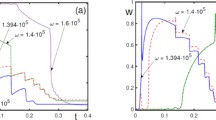Abstract
It is shown that Torry’s theory of nutation based on the Bloch equations for the magnetization vector cannot be used for describing the “nutation” of interacting spins (including the splitting of spin energy levels in zero magnetic field). The Bloch equations presume that the magnetic moment vector of spins fully determines the spin state. However, this is true of only noninteracting particles with spin S = 1/2. Systematic analysis is performed for the response (“nutation”) of spins to the instantaneous application of an alternating magnetic field for the simplest system with spin S = 1 as an example. The dependence of spin nutation on the spin–spin interaction and the pattern of excitation of spins by an alternating field is analyzed in detail. In the conditions when the spin–spin interactions are comparable with of the spin interaction with the alternating field, the motion of spin magnetization is described as the sum of contributions oscillating with different frequencies, which are equal to the frequencies of transitions between the eigenstates of the spin Hamiltonian in a rotating coordinate system. For the first time, the spin “nutation” is described using the Heisenberg mathematical apparatus. In this approach, the equations of motion are written directly for quantities measured in experiment. The complete orthogonal set of quantities for spins consists of the dipole moment and multipole polarizations. For demonstrating the potential of this description of “nutation,” the specific case of paramagnetic particles with spin S = 1 is considered. Coupled equations of motion for the dipole and quadrupole moments are obtained with account for the energy of splitting in zero magnetic field. These equations can be referred to as generalized equations for the magnetic polarization of spins. The equations show that in the presence of spin–spin interactions, the reversible mutual conversion of the dipole and quadrupole moments occurs. This leads to oscillations of the length of the spin magnetization vector, the projection of which is usually observed in experiment. Therefore, the experimentally observed oscillations of the magnetization projections reflect the nutation of the magnetization vector as well as the modulation of the length of this vector due to mutual conversion of the dipole and quadrupole polarizations.








Similar content being viewed by others
REFERENCES
H. C. Torry, Phys. Rev. 76, 1059 (1949).
R. R. Ernst, G. Bodenhausen, and A. Wokaun, Principles of Nuclear Magnetic Resonance in One and Two Dimensions (Clarendon, Oxford, 1987).
I. J. Lowe and R. E. Norberg, Phys. Rev. 107, 46 (1957).
A. V. Astashkin and A. Schweiger, Chem. Phys. Lett. 174, 595 (1990).
A. Schweiger and G. Jeschke, Principle of Pulse Electron Paramagnetic Resonance (Oxford Univ. Press, Oxford, 2001).
S. S. Kim and S. I. Weissman, J. Magn. Reson. 24, 167 (1976).
R. Furrer, E. Fujara, C. Lange, et al., Chem. Phys. Lett. 75, 332 (1980).
R. Hanaishi, Ya. Ohba, K. Akiyama, et al., J. Chem. Phys. 103, 4819 (1995).
L. D. Landau and E. M. Lifshitz, Course of Theoretical Physics, Vol. 3: Quantum Mechanics: Non-Relativistic Theory (Pergamon, New York, 1977; Fizmatlit, Moscow, 2004).
R. Janssen and W. S. Veeman, J. Chem. Soc., Faraday Trans. 1 84, 3747 (1988).
G. M. Zhidomirov and K. M. Salikhov, Sov. Phys. JETP 29, 1037 (1969).
D. A. Varshalovich, A. N. Moskalev, and V. K. Khersonskii, Quantum Theory of Angular Momentum (Nauka, Leningrad, 1975; World Scientific, Singapore, 1988).
H.-J. Stoeckmann and D. Dubbers, New J. Phys. 16, 1 (2014).
K. M. Salikhov, F. S. Sarvarov, and R. Z. Sagdeev, Chem. Phys. 16, 41 (1976).
K. M. Salikhov, Yu. N. Molin, R. Z. Sagdeev, and A. L. Buchachenko, Spin Polarization and Magnetic Effects in Radical Reactions (Academic Kiado, Budapest; Elsevier, Amsterdam, 1984).
ACKNOWLEDGMENTS
The author’s interest in this problem was induced by experiments performed by his colleagues R.B. Zaripov, A.A. Sukhanov, and V.F. Tarasov at the Kazan Physico-Technical Institute. Thanks are also due to R.T. Galeev and A.G. Mar’yasov for numerous fruitful discussions.
Author information
Authors and Affiliations
Corresponding author
Ethics declarations
The authors declare that they have no conflicts of interest.
Additional information
Translated by N. Wadhwa
Rights and permissions
About this article
Cite this article
Salikhov, K.M. A New View on Spin “Nutation”. J. Exp. Theor. Phys. 135, 617–631 (2022). https://doi.org/10.1134/S1063776122110164
Received:
Revised:
Accepted:
Published:
Issue Date:
DOI: https://doi.org/10.1134/S1063776122110164




